|
Compared to the sporting arms market, the
introduction of a new military small arm cartridge is a rare
event and somewhat on the order of a panda getting pregnant at
the Washington D.C. Zoo, or a politician at that other zoo in
Washington convicted of telling the truth.
In this world of NATO standardization a new service
cartridge just doesn’t happen all that often and it’s even
more unusual now that many of the former eastern European
countries are adopting NATO standard small arms and ammunition
while abandoning their former Communist origin arms and
calibers. Therefore
it was more than noteworthy when FNH of Belgium responded
to a NATO request proposal for a new class of “personal
defense weapon” during the late 1980’s and early 1990’s by
introducing a gun to meet the specifications with their P90 and
its 5.7x28mm cartridge.
NATO felt there would be increased use of
protective, flexible body armor by the military of all nations
in the decades to come and therefore called for this new class
of individual service weapons.
I was fortunate during a European trip in 1993 in that I
was allowed to test the new selective-fire weapon designed for
this round -- the P90 at FN’s test range near Herstal,
Belgium.
The P90 is something of an odd military small
arm. It was never
designed to be a standard military service rifle, but was
actually designed as a weapon for rear echelon troops like motor
pool mechanics, drivers, cooks and bakers as well as a special
purpose weapon for troops engaging in close quarter battle.
The idea behind it is previous pistol caliber weapons;
i.e. pistols and submachine guns, were becoming increasingly
ineffective against issued protective body armor while standard
service issue assault rifles were too heavy or unwieldy for
either rear echelon troops or for use in close quarter battle
scenarios.
Because of its new cartridge the FNH P90 can’t
truly be classified as a submachine gun, but then it really
doesn’t qualify as a traditional assault rifle either.
One of the design characteristics of the P90 and its
associated 5.7x28mm round is the fact it was designed from the
get-go to have a limited range.
Yes, the ammo was designed to defeat both soft and some
hard body armor, even some of the heaviest in use by former
soviet military forces, but it was also designed to have a
limited lethal range. It
was not meant for long range use.
I was informed in Belgium back in 1993 that it had a
practical range limit of approximately 150 meters.
Testing on the civilian legal ammo available with the
semi-auto test sample shown here indicates it is good to 200
yards, but that is probably its absolute practical limit.
OK, over a decade has passed since the gun and
cartridge’s introduction and the only thing that can be said
is the obvious. It
has NOT proven to be an overwhelming or revolutionary design.
Whether this will change in the future remains to be
seen, but the world has NOT beaten a path to FNH’s door
demanding vast quantities of these weapons or this cartridge.
Yes, some FN P90 carbines were used by the hostage rescue
teams like the well known rescue event during an embassy siege
in Peru, but overall its acceptance and success has been one of
a limited nature. Rumor
has it that Saudi Arabia has purchased a substantial number, but
other foreign sales have been limited at best.
There are some American law enforcement agencies,
including Secret Service protective teams, equipped with the gun
on their tactical units and the operators sing their praises on
various web sites, but the gun and its cartridge are not without
their critics.
All of this is important to keep in mind when
one starts examining and reviewing the civilian legal version of
the FNH P90, the FNH PS90.
Especially so when one understands from the very
beginning the ammunition this design concept was originally
developed around is forbidden to civilians.
It is the first example in my memory where the
ammunition; specifically the SS190 round is classified the same
as select-fire weapons or sound suppressors.
The armor piercing ammunition is a Class III item in and
of itself.
Then the question becomes: what is the civilian
legal version of the P90, or the PS90, good for?
What purpose and what role does it serve in the civilian
sporting arms market, other than the obvious, “Gee, it sure
looks really neat??” And
how good is the civilian legal ammunition?
What will it do and what will it not do?
LET’S START WITH THE AMMO…
When I tested the prototype P90 in Belgium back
in the early 1990’s there was a problem with the ammunition. The ammunition used during my test session, I was told,
consisted of a 23 grain full metal jacket projectile with a
plastic or polymer core. The
problem was, and I observed it firsthand, resulting two groups
on the 100 meter paper target from either semi-auto fire or
full-auto fire. The
main group was more or less point of aim/point of impact and the
second group (approximately one third of the rounds fired) was
found roughly four inches to the right and four inches high from
the point of aim group. At
the time they didn’t have an answer for this problem but
admitted it was a serious concern. In 1994 this round was abandoned in favor of the heavier
SS190 projectile with its steel penetrator and aluminum core.
It is strictly a guess on my part, but the dispersion
problem had to be part of the reason why the lightweight
5.7x28mm projectile was discarded.
That is a shame really because it is my view the
lighter projectiles with this combination of the PS-90 and the
5.7x28mm could provide the civilian centerfire competitor with a
combination not found with any other centerfire gun and
cartridge combination currently available.
Why is this important?
Because it is easy for most civilian shooters to find
places to shoot their handguns and shotguns in competition in
just about any location you care to mention in this country, but
it is becoming increasing difficult to find a venue where it is
safe to shoot centerfire rifles and carbines.
We are desperately short of rifle ranges in America,
square range or otherwise, and it is even harder to find a range
where you can have an action oriented centerfire rifle/carbine
competition without the issue of ricochets and wayward
over-the-berm rounds compromising range safety.
During my testing of the sample PS90 I used two
specific 5.7x28mm rounds; the SS195LF (lead free) and the
SS197SR (sporting round) with a blue polycarbonate Hornady
40 grain V-Max bullet. Other rounds available at one time or another in 5.7x28mm,
but not used in this report, include the SS191 Tracer which has
a trajectory identical to the SS190.
This round is identified by a painted red tip on the
projectile. The discontinued SS192 hollow point round which used a 28
grain unmarked projectile and is distinguished from the SS195LF
by the use of a brass colored primer, the SS193 sub sonic round
which employs a 55 grain Sierra FMJ-boat tail bullet and was
designed for use with a sound suppressor.
The discontinued T194 round which is identified by a
painted green projectile tip and a silver colored primer and was
used as a training round until being replaced by the SS192 and
SS195 rounds, and the discontinued SS196SR which used a red
polycarbonate Hornady V-Max 40 grain bullet.
The criticism of the 5.7x28mm cartridge centers
around the question of its stopping power or whether it will
stop an armed antagonist. Dr.
Martin Fackler was an early critic of the round when he
postulated it was little more than a centerfire version of the
.22 Rimfire Winchester Magnum round.
Since the ability to defeat soft body armor is legally
denied by authorities at various levels to civilian shooters,
one has to seriously ponder the terminal ballistics of this
small centerfire round with the ammo available.
Most of the test data that has been published
has almost always employed the civilian-prohibited SS190 round
and its performance is questionable at best.
The current FBI standard for projectile penetration depth
in 10% gelatin is twelve inches, but published test data from
tests by the Royal Canadian Mounted Police Academy forensics lab
indicates an average depth of only 10.4 inches.
Dr. Gary Roberts has tested the P90 with the SS190
ammo and found his results averaged the minimum of twelve inches
in 10% gelatin. Anecdotal
reports involving actual shootings by law enforcement special
response officers armed with P90s range from instant
incapacitation to incidents where the perpetrator stopped his
criminal behavior but complained about being shot five or six
times from the full-auto fire.
Obviously, the issue is uncertain as this round’s
ability to stop enraged criminals cold in their tracks has yet
to be demonstrated on a regular basis.
The prudent civilian should examine alternative
cartridges and carbines if they are searching for a tactical
carbine for home defense and select one with a better reputation
for finalizing unwanted criminal behavior.
For applications outside the lethal force arena, the gun
may very well prove ideal with its low felt recoil and limited
range, but I have yet to use it on anything walking or crawling
across my farm, so my personal final verdict has yet to be
delivered.
THE GUN ITSELF…
The shape and overall outline of the FNH P90 and
PS90 is unique and looks for all the world like something out of
a sci-fi film. It
is a bullpup design in that the operating mechanism is located
well behind the trigger. Although
the gun has a significant retail price (in excess of $1,600
depending upon the retailer) it uses a large amount of polymer
components as well as a cast aluminum receiver so I believe it
is not as an expensive gun to manufacture as what FNH would like
everyone to believe.
Two features characterize the FNH P90 and PS90.
The first is the horizontal magazine that lays inline
with the action and over the barrel and the second is the shape
of the forward handguard. The
latter feature is curved and looks for all the world like
something taken off a musical instrument.
The designers went to great lengths to guarantee a
completely ambidextrous firearm as the gun works equally well
for either right or left handed shooters.
It is described in various journals and
publications as a blowback operated firearm in that the barrel
is not locked to the action.
But, there is a key characteristic everyone is failing to
note, and that is upon firing the PS90 barrel MOVES.
Granted, it is a small movement, approximately 0.030 of
an inch, but it moves none-the-less and a key definition of any
recoil operated firearm is the barrel MOVES.
The barrel must move to maintain safe chamber pressure
until the bullet, like Elvis, has left the barrel.
For a round that many classify as a pistol round it
operates at relatively high pressure, somewhere around 50,000
psi. Hence, the
need for some mechanism to guarantee everything stays connected
until Elvis has left the building.
The PS90 comes with either an olive green
plastic body or a black plastic body.
(I’m sure all the drugstore commandos will scarf up the
black ones because they are limited in number and look so
radical. I hate to
shake their fantasies, but black objects show up easier in low
light conditions with night vision devices, so I’ll stick with
the olive green version, even if it isn’t as cool looking.)
This plastic body consists of two halves which are bolted
together and form the chassis (the frame and trigger group, item
#1) which carries (item #2) the barrel support and optical sight
group, (item #3) the moving parts group, (item #4) the hammer
group and (item #5) the magazine.
There is a great deal of similarity between the layout of
the P90/PS90 and the much older Steyr AUG that must be
recognized and acknowledged.
The magazine holds fifty rounds when used by the
P90, but the test PS90 came with a fifty round magazine that was
blocked to thirty round capacity.
The question is...why?
Unfortunately I can’t provide an answer, but you can find a nifty little replacement follower for a
reasonable price that will substitute for their elongated block
and you will regain a full fifty round capacity with the
supplied magazine.
The ammunition lies cross-wise to the bore-line
in the magazine and at the final moment prior to feeding is
turned ninety degrees by the magazine feed lips.
It is a curious arrangement, but one that works well.
The magazine body is a smoky translucent polymer which
some feel is a real big deal in that you can see how many rounds
are in the mag body, but experience with other guns and
magazines offering this feature reveals it is of limited value.
The big problem with these magazines seems to be the
method of carry for the spare mags as the improper carry can
cause rounds to spill from the magazine.
FNH provides a rubber cup for each spare mag to prevent
this from happening on their military P90 mag pouches.
The trigger pull on bullpup designs is usually
heavy and hard to distinguish and the PS90 stays true to form in
this regard. It is
heavy, too heavy to measure on my RCBS trigger pull scale which
goes up to six pounds and the action or motion of the trigger is
mushy.
THE SIGHT BLOWS…
In all my years of working with hand held
firearms, I have never encountered a more difficult to use and
poorly designed piece of sighting equipment as that found with
the MC-10-80 Ring Sight reflex sight which is mounted on the
PS90 and P90. In my
opinion it has to be one of the dumbest ideas ever sold to a
firearms manufacturer; major or otherwise.
If that statement makes me out to be an opinionated,
prejudiced, narrow minded son of a you-know-what, so be it.
I ask you; who would use a white colored reticle
on a reflex sight for climates well north of the Tropic of
Cancer? In bright
daylight it washes out. Against
any kind of light background such as a white building, it washes
out. It will wash
out against a well lit cloudy sky and by ‘wash out’ I mean
it just flat disappears. I
just can’t imagine how this thing would work in a snow covered
field or snowy backyard in the dead of winter.
To be fair, there is a PS-90 variant which uses
a black ring reticle, but one has to ask why the black ring
isn’t the model being usually shipped and the white ring Ring
Sight the optional product?
The reticle seen with the Ring Sight reflex
sight consists of a white colored outer ring that approximates
180 MOA and inside it is a smaller white colored ring
representing approximately 20 MOA and inside that at the center
is a single white dot which is 1 MOA.
In low light conditions there is a horizontal bar on
either side of the center dot and a vertical bar below it that
becomes visible and creates something of a “T” shaped
reticle aiming system. I found the white colored lines turned to a pinkish rose
color in low-light conditions, but the acquisition time for my
eyes was not what I have experienced with traditional red-dot
sighting systems, whether they were battery powered or tritium.
In short, I found this sighting system extremely
inadequate by any measure one would choose to evaluate its
performance.
A better alternative is offered by Halo
Manufacturing (web site: www.halomfg.com)
and it is called the TriRail.
I know FNH is offering a three Picatinny rail version of
the P90 and PS90, but the truth is I feel the Halo Mfg. TriRail
is a better product. Once
a Picatinny rail is substituted for the horrible Ring Sight,
then the question is whether you mount a red dot sight or a
traditional cross-hair scope sight in its place.
An option I feel that should have been offered in the
very beginning.
Even with the horrid factory installed Ring
Sight; there is a crude alternative with a u-notch and post on
either side of the Ring Sight as part of the base mount for the
Ring Sight.
TESTING THE PS90…
Testing consisted of a number of informal range
sessions shooting tubular objects such as empty adult beverage
cans on a regular basis at short range and one formal range
session at 100 yards on a square range.
The square range session revealed the SS197SR ammo to be
capable of five round groups measuring right at an inch,
center-to-center. The
SS195LF ammo was not nearly as accurate as the best group with
this stuff just made three inches in diameter.
A better trigger and a better sighting system would have,
without question, shrunk these groups by a considerable measure.
Still I have hopes for the device once a better sighting
system is installed.
SUMMARY…
I must confess I purchased the test sample,
which I don’t do all that often anymore.
Simple human greed was one reason why I purchased this
gun, because if the Democrats win the major elections in ’08
it is a virtual certainly the PS90 will be prohibited from
future sales and I believe that makes this purchase a good
investment because years later it will double, triple or gain
equity at an exponential rate.
Secondly, I believe there is merit to the
cartridge and gun combination for civilian applications if the
suitable lightweight, limited range ammunition is ever
developed. We as a
shooting society truly need some sort of carbine for competition
that can be safely fired on most all outdoor pistol ranges.
Thirdly, the magazine holds fifty BBs.
Granted, they are small, underpowered BBs, but there are
fifty of them none-the-less and no one knows just how important
that may prove in future years and situations.
Is
this gun and ammo combination worth the exorbitant price? You will have to answer that question for yourself as I did
for myself. The FNH
PS90 is not a perfect design by any means but it remains an
interesting one and that alone may be its most endearing
feature.
Frank
W. James
Specifications...
THE FNH PS90
Manufacturer:
FNH USA, LLC, P.O. Box 697, McLean, VA 22101
Tel: 703-288-1292
Web: www.FNHUSA.com
MODEL: PS90
MECHANISM TYPE: blowback
operated, semi-automatic bullpup carbine
CALIBER: 5.7x28mm
OVERALL LENGTH: 26.2
inches
WEIGHT: 6.4
pounds empty, 7.5 pounds when fully loaded w/50 rounds
BARREL LENGTH:
16.04 inches
RATE OF TWIST: One
turn in 9 inches
MAGAZINE CAPACITY:
30 rounds as shipped, 10
rounds for those states that restrict magazine capacity
  
Got something to say about this article? Want to agree (or
disagree) with it? Click the following link to go to the GUNBlast Feedback Page.
|
|
Click pictures for a larger version.
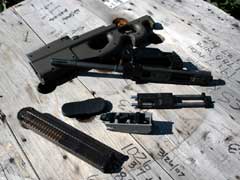
The
PS90 breaks down easily into the frame & trigger group
(shown here at the top), the barrel support and optical sight
group (next down), the moving parts group (shown here in the
middle), the hammer group (shown here as the gray box below
the moving parts group), and the magazine (seen here at the
bottom left of the photo).
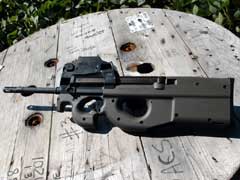
The
PS90 is a semi-auto civilian legal derivative of the FNH
select fire military and law enforcement P90 bullpup carbine.
It chambers the 5.7x28mm cartridge.
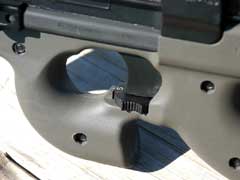
The
fire selector is the only external safety and it has two
positions; SAFE and FIRE.
It rotates horizontally.
Internally the PS90 has a safety which blocks the sear
should the gun be dropped that prevents an accidental
discharge.
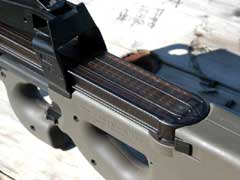
One
of the distinguishing characteristics of the PS90 is its
horizontal translucent polymer magazine that lays inline with
the barrel.

The
author feels the MC-10-80 Ring Sight reflex sight with its
white colored reticule is the worst sighting device he has
ever experienced on any small arm.
Against any bright or light colored surface or
background it washes out and the aiming point disappears.
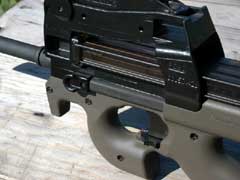
Many
of the features of the PS90 are ambidextrous, like the cocking
handle shown here.
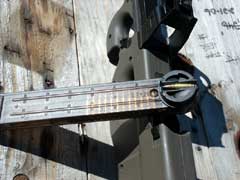
Because
the cartridges lay crosswise in the polymer magazine, the feed
lips on the magazine must turn each round ninety degrees prior
to feeding. The
author reports it is a system that works well.
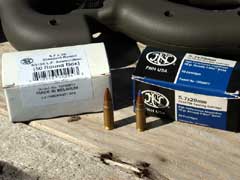
The
author used two different 5.7x28mm rounds during the testing
of the FNH PS90, the SS195LF ammo (seen here on the left), and
the SS197SR ammo (shown here on the right). The SS197SR was
the more accurate of the two.
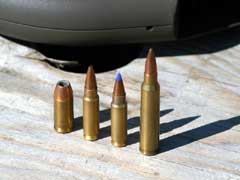
The
5.7x28mm grew out of a NATO RFP issued in the late 1980’s.
Shown here for comparison purposes is a commercial
9x19mm hollow point round (far left), the SS195LF round, the
SS197SR round and finally on the far right a 69 grain
5.56x45mm military rifle round.
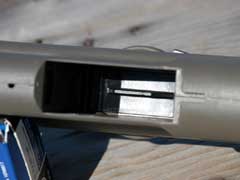
The
PS90 ejects the fired case out the bottom of the stock.
This ejection port within the stock is equipped with a
dust cover that is shown here in the closed position.

Should
the optical sight fail, the PS90 is equipped with a crude form
of iron sights. Shown
here are the rear u-notch sights on either side of the optical
sight mount.

This
is the front sight blade for the iron sights, found on either
side of the optical sight mount.
|
![]()